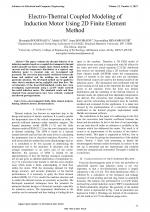| 2/2021 - 4 |
Electro-Thermal Coupled Modeling of Induction Motor Using 2D Finite Element MethodBOUHERAOUA, M. |
| Extra paper information in |
| Click to see author's profile in |
| Download PDF |
Author keywords
electromagnetic fields, finite element analysis, heating, induction motors, thermal analysis
References keywords
thermal(23), machines(12), analysis(11), systems(9), induction(9), model(8), electric(8), power(7), motor(7), magnetics(7)
Blue keywords are present in both the references section and the paper title.
About this article
Date of Publication: 2021-05-31
Volume 21, Issue 2, Year 2021, On page(s): 33 - 40
ISSN: 1582-7445, e-ISSN: 1844-7600
Digital Object Identifier: 10.4316/AECE.2021.02004
Web of Science Accession Number: 000657126200004
SCOPUS ID: 85107621073
Abstract
The paper evaluates the thermal behavior of an induction machine based on a coupled electromagnetic-thermal model using 2D non-linear complex finite element method. The currents and the temperature distribution in a squirrel cage induction motor in transient state are investigated and presented. The convection heat transfer coefficient between the frame and ambient and the windings are treated with particular attention. The developed method can be applied to other electric machines having negligible axial heat flow. The corroboration of the theoretical/simulated results have been investigated, experimentally using a 2.2 kW totally enclosed fan-cooled induction motor. The simulated results and those obtained from measurements have been critically evaluated and showed good agreements. |
| References | | | Cited By |
Web of Science® Times Cited: 6 [View]
View record in Web of Science® [View]
View Related Records® [View]
Updated 2 weeks, 5 days ago
SCOPUS® Times Cited: 8
View record in SCOPUS® [Free preview]
View citations in SCOPUS® [Free preview]
[1] A least squares–support vector machine for learning solution to multi-physical transient-state field coupled problems, Han, Xiaoming, Zhao, Xin, Wu, Yecheng, Qu, Zhengwei, Li, Guofeng, Engineering Applications of Artificial Intelligence, ISSN 0952-1976, Issue , 2024.
Digital Object Identifier: 10.1016/j.engappai.2024.109321 [CrossRef]
[2] A comprehensive overview of high-speed solid-rotor induction machines: Applications, classification, and multi-physics modeling, Bilek, Vladimir, Barta, Jan, Toman, Marek, Losak, Petr, Bramerdorfer, Gerd, International Journal of Electrical Power & Energy Systems, ISSN 0142-0615, Issue , 2025.
Digital Object Identifier: 10.1016/j.ijepes.2025.110520 [CrossRef]
[3] Thermal finite element modeling and simulation of a squirrel-cage induction machine, Bergfried, Christian, Späck-Leigsnering, Yvonne, Seebacher, Roland, Eickhoff, Heinrich, Muetze, Annette, International Journal of Applied Electromagnetics and Mechanics, ISSN 1383-5416, Issue 1-2, Volume 76, 2024.
Digital Object Identifier: 10.3233/JAE-230233 [CrossRef]
[4] Procedure for the Accurate Modelling of Ring Induction Motors, Tomczyk, Krzysztof, Makowski, Tomasz, Kowalczyk, Małgorzata, Ostrowska, Ksenia, Beńko, Piotr, Energies, ISSN 1996-1073, Issue 17, Volume 14, 2021.
Digital Object Identifier: 10.3390/en14175469 [CrossRef]
[5] Considerations on Matrix-Based, Analytical Temperature Prediction Tools for Electrical Machines, Lian, Xuewen, Galea, Michael, Camilleri, Robert, 2024 International Conference on Electrical Machines (ICEM), ISBN 979-8-3503-7060-7, 2024.
Digital Object Identifier: 10.1109/ICEM60801.2024.10700266 [CrossRef]
[6] Effects of Voltage Harmonics on the No-load losses of a Three-phase Distribution Transformer, Dawood, Kamran, Komurgoz, Guven, 2021 13th International Conference on Electrical and Electronics Engineering (ELECO), ISBN 978-605-01-1437-9, 2021.
Digital Object Identifier: 10.23919/ELECO54474.2021.9677695 [CrossRef]
Disclaimer: All information displayed above was retrieved by using remote connections to respective databases. For the best user experience, we update all data by using background processes, and use caches in order to reduce the load on the servers we retrieve the information from. As we have no control on the availability of the database servers and sometimes the Internet connectivity may be affected, we do not guarantee the information is correct or complete. For the most accurate data, please always consult the database sites directly. Some external links require authentication or an institutional subscription.
Web of Science® is a registered trademark of Clarivate Analytics, Scopus® is a registered trademark of Elsevier B.V., other product names, company names, brand names, trademarks and logos are the property of their respective owners.
Faculty of Electrical Engineering and Computer Science
Stefan cel Mare University of Suceava, Romania
All rights reserved: Advances in Electrical and Computer Engineering is a registered trademark of the Stefan cel Mare University of Suceava. No part of this publication may be reproduced, stored in a retrieval system, photocopied, recorded or archived, without the written permission from the Editor. When authors submit their papers for publication, they agree that the copyright for their article be transferred to the Faculty of Electrical Engineering and Computer Science, Stefan cel Mare University of Suceava, Romania, if and only if the articles are accepted for publication. The copyright covers the exclusive rights to reproduce and distribute the article, including reprints and translations.
Permission for other use: The copyright owner's consent does not extend to copying for general distribution, for promotion, for creating new works, or for resale. Specific written permission must be obtained from the Editor for such copying. Direct linking to files hosted on this website is strictly prohibited.
Disclaimer: Whilst every effort is made by the publishers and editorial board to see that no inaccurate or misleading data, opinions or statements appear in this journal, they wish to make it clear that all information and opinions formulated in the articles, as well as linguistic accuracy, are the sole responsibility of the author.



